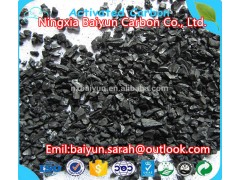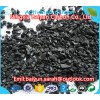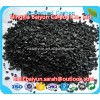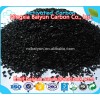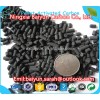Coconut shell activated carbon can be made from a wide variety of carbon-containing substances, these materials include wood, sawdust, coal, coke, peat, lignin, lignite, petroleum residues and the like. Including coal and coconut shell activated carbon has become the most commonly used materials, shape of amorphous particles, the appearance is black, granular, high mechanical strength, developed pore structure, large surface area, adsorption speed, high adsorption capacity, easy regeneration, durability and other characteristics.

Coconut shell activated carbon
Coconut shell activated carbon physical and chemical properties analysis:
| project | Test Data | project | Test Data |
| Particle size | mixing | True specific gravity | 2-2.2g/cm3 |
| Benzene adsorption rate of powder | ≥450mg/g | Bulk density | 0.5-0.65g/cm3 |
| strength | ≥80-95% | The total pore volume | 0.7-1cm3/g |
| Iodine value | 700-1000mg/g | The specific surface area | 590-1500m2/g |
| Methylene blue value | 100-150mg/g | PH | 6月9日 |
| Dechlorination half the value | ≤5cm | Ash | ≤3% |
| Moisture | ≤10% | Specific heat | -1.00J/g.℃ |
The role of coconut shell activated carbon
1. Gas adsorption often use coconut shell activated carbon, usually let the air flow through the activated carbon adsorption layer. According to a different layer of activated carbon adsorption unit, adsorption layer in which the state has a fixed layer, and flow moving layer of several layers. However, in the electric frost and deodorizer like a small car within the adsorber, coconut shell activated carbon depend on convection and diffusion of gas adsorption.
2. coconut shell activated carbon can also be used in the instrument room, air-conditioned rooms, basements and submarine air purification facilities, due to external contamination or affected populations in a closed environment activities, often containing body odor, smoke odor, cooking odor, oil, organic and inorganic sulfur compounds, and other corrosive ingredients, resulting in precision instruments corrosion or affect human health.
3. coconut shell activated carbon in chemical plants, tanneries, paint factory and the use of various organic solvents engineering exhaust gases, containing various organic solvents, inorganic and organic sulfur compounds, hydrocarbons, chlorine, oil, mercury and other environmentally harmful ingredients, then emissions can later by activated carbon adsorption.
4. atomic energy facility exhaust gases, krypton, xenon, iodine and other radioactive substances, it is necessary to use coconut shell activated carbon adsorption and clean them again after discharge. Coal, heavy oil combustion flue gas containing sulfur dioxide and nitrogen oxides, which are polluting the atmosphere to form acid rain, harmful ingredients, you can also use coconut shell activated carbon adsorption to remove them.
5. coconut shell activated carbon for gas purification are still many use cases, such as gas masks, cigarette filters, refrigerator deodorant, car exhaust treatment device, are excellent with activated carbon adsorption properties, the gas toxic ingredients to human adverse components or malodorous components were removed. For example, after joining the 100 ~ 120ng activated carbon in cigarette filters, see Table 3-6-2, will be able to smoke harmful component removing a large part.
Ningxia Ming Yang factory specializing in the production and sale of activated carbon: coconut shell activated carbon, nutshell activated carbon, activated carbon industry, water treatment materials. Contact: 086-182-9502-3799. Coconut shell activated carbon coconut shell as raw materials, production process from finishing series, with a gap developed good adsorption properties, high strength, durable economic advantages. Products are mainly used for drinking water, pure water, wine, beverage, industrial wastewater purification, bleaching, dechlorination, deodorant, desiccant, catalyst support and so on.

